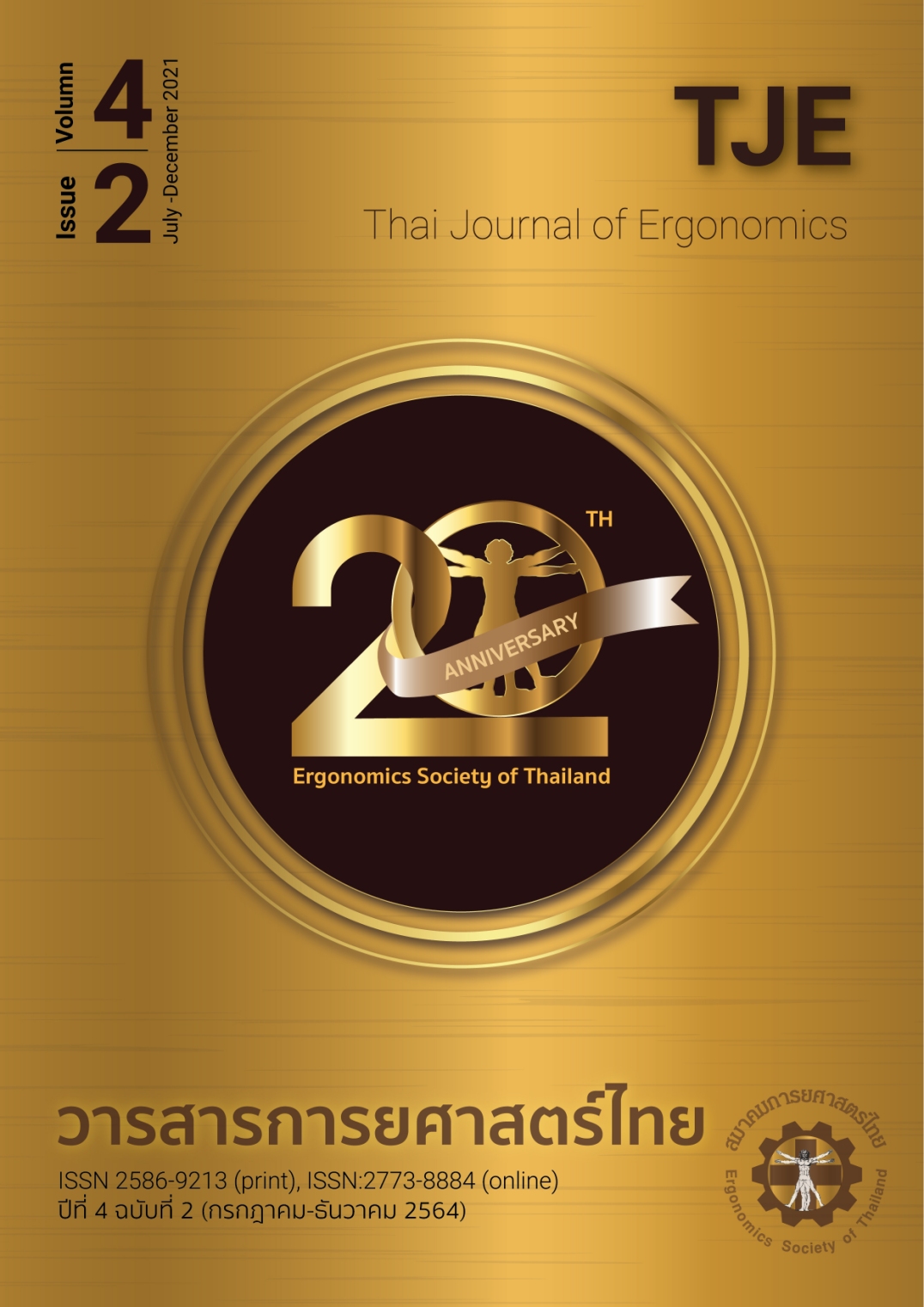Prevalence of work-related musculoskeletal disorders, pain in difference body area, and stress level in office workers
Main Article Content
Abstract
Work-related musculoskeletal disorders (WMSDs) are the most common in office workers who are in the prolonged sitting in working hours with the computer. The aim of this study was to explore the prevalence of WMSDs, level of pain in the different body area, and level of stress in office workers. There were 561 male and female office workers participated in this study. Data were collected by using the Online Self-report Questionnaires on Computer Work-related Exposure (OSCWE) and data analyzed by using descriptive statistics. The prevalence of WMSDs in 7 days was found 27.2% (153 office workers) and WMSDs in 12 months was found 33.3% (187 office workers). The most pain level in in the body area were found in the neck (VAS=3.56), shoulder (VAS=2.76), and lower back (VAS=2.07). The part of body area with the highest pain levels in the past 7 days were: the lower back, shoulder, and wrist. There were 422 office workers reported the stress domain, the result of 56.4% of them have moderate stress and 21.6% have high level of stress (mean score=34.75 ±13.40). The cause of stress was fear of work error, did not reach to the goal of work, and have muscular tension. Data obtained from this study may use as the preliminary information and use as a guideline for further surveillance, planning, health promotion, and prevention of musculoskeletal disorders in office workers and can be used to improve in the office ergonomics.
Article Details
References
Global Burden Disease. Global burden of 369 diseases and injuries in 204 countries and territories, 1990-2019: a systematic analysis for the Global Burden of Disease Study 2019. Lancet (London, England). 2020;396:1204-22.
Status report of disease and health hazards fron occupational and environmental year 2018 [Internet]. Department of disease control, Ministry of Public Health. 2018 [cited 2021 September 15]. Available from: http://envocc.ddc.moph.go.th/contents/view/790.
Janwantanakul P, Pensri P, Jiamjarasrangsri V, Sinsongsook T. Prevalence of self-reported musculoskeletal symptoms among office workers. Occup Med (Oxford, England). 2008;58:436-8.
Ayanniyi O, Ukpai BO, Adeniyi AF. Differences in prevalence of self-reported musculoskeletal symptoms among computer and non-computer users in a Nigerian population: a cross-sectional study. BMC Musculoskelet Disord. 2010;11:177.
Eltayeb S, Staal JB, Hassan A, de Bie RA. Work related risk factors for neck, shoulder and arms complaints: a cohort study among Dutch computer office workers. J Occup Rehab. 2009;19:315-22.
Hannan LM, Monteilh CP, Gerr F, Kleinbaum DG, Marcus M. Job strain and risk of musculoskeletal symptoms among a prospective cohort of occupational computer users. Scand J Work Environ Health. 2005;31:375-86.
Wahlström J, Lindegård A, Ahlborg Jr G, Ekman A, Hagberg M. Perceived muscular tension, emotional stress, psychological demands and physical load during VDU work. Int Arch Occup Environ Health. 2003;76:584-90.
Kuorinka I, Jonsson B, Kilbom A, Vinterberg H, Biering-Sørensen F, Andersson G, et al. Standardised Nordic questionnaires for the analysis of musculoskeletal symptoms. Appl Ergon. 1987;18:233-7.
Mekhora K, Jalayondeja W, Jalayondeja C, Bhuanantanondh P, Dusadiisariyavong A, Upiriyasakul R, et al. Online self-report questionnaire on computer work-related exposure (OSCWE): Validity and internal consistency. 2014;97(Suppl 7):S80-3.
Mahatnirunkul S, Pumpaisanchai W, Tarpunya P. Suanprung Stress Test-20, SPST-20. Bangkok: Department of Mental Health Ministry of Public Health; 2002.
Jalayondeja C, Jalayondeja W, Mekhora K, Bhuanantanondh P, Dusadi-Isariyavong A, Upiriyasakul R. Break in sedentary behavior reduces the risk of noncommunicable diseases and cardiometabolic risk factors among workers in a petroleum company. Int J Environ Res Public Health. 2017;14:501.
วรรธนะ ชลายนเดชะ, ชุติมา ชลายนเดชะ, เวทสินี แกวขันตี, อัมพร นันทาภรณศักดิ์. ผลของโปรแกรมส่งเสริมกิจกรรมทางกายและเบรกการนั่งนานต่อสุขภาพและสมรรถภาพทางกายของพนักงานในสำนักงาน. วารสารการพยาบาลและสุขภาพ. 2562;13:91-106.
Wongwitwichote K, Jalayondeja W, Mekhora K, Jalayondeja C. Physical activity, sitting time and work-related musculoskeletal disorders in computer workers. Jpn J Ergon. 2017;53(Suppl 2):S450-3.
Klussmann A, Gebhardt H, Liebers F, Rieger MA. Musculoskeletal symptoms of the upper extremities and the neck: a cross-sectional study on prevalence and symptom-predicting factors at visual display terminal (VDT) workstations. BMC Musculoskelet Disord. 2008;9:96.
Luemongkol R, Chaiklieng S. Musculoskeletal disorders and work stress among emergency nurses at the regional hospitals in the northeast of Thailand. Srinagarind Med J. 2014;29:516-23.
Kentawai W, Kongtawelert A, Sujirarat D, Bhuanantanondh P. Prevalence of musculoskeletal disorders among female pottery workers in Khiri Mat, Sukhothai Province, Thailand. J Sci Technol MSU. 2019;38:282-91.
Huysmans MA, Blatter BM, van der Beek AJ. Perceived muscular tension predicts future neck-shoulder and arm-wrist-hand symptoms. Occup Environ Med. 2012;69:261-7.
Paksaichol A, Lawsirirat C, Janwantanakul P. Contribution of biopsychosocial risk factors to nonspecific neck pain in office workers: A path analysis model. J Occup Health. 2015;57:100-9.
Cho CY, Hwang YS, Cherng RJ. Musculoskeletal symptoms and associated risk factors among office workers with high workload computer use. J Manipulative Physiol Ther 2012;35:534-40.
สุธีรา ใจดี, สสิธร เทพตระการพร, สิริมา มงคลสัมฤทธิ์. ความชุกและปัจจัยที่มีความสัมพันธ์ต่อการเกิดอาการทางระบบกระดูกและกล้ามเนื้อในกลุ่มพนักงานทำความสะอาดของมหาวิทยาลัยธรรมศาสตร์. วารสารการส่งเสริมสุขภาพและอนามัยสิ่งแวดล้อม 2560;40:82-94.


